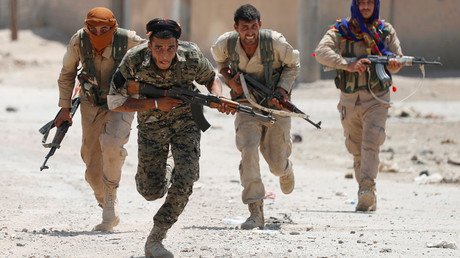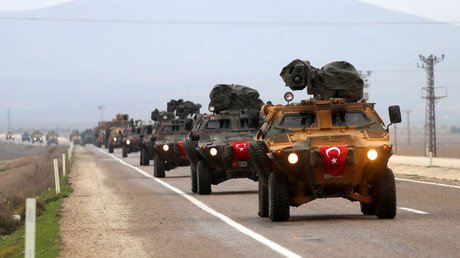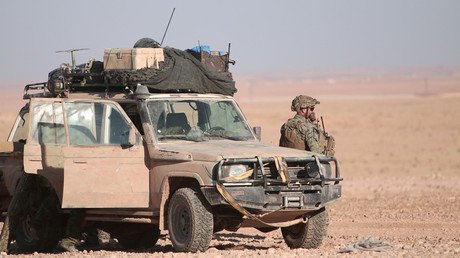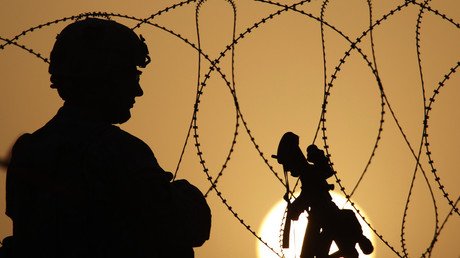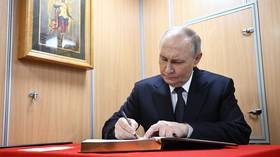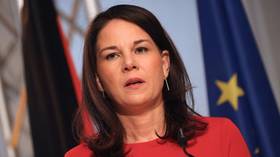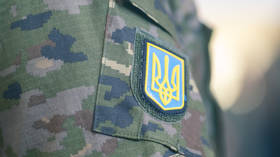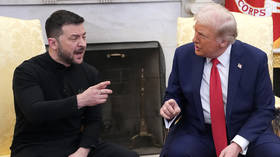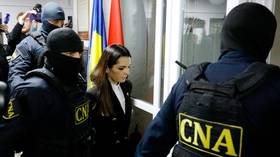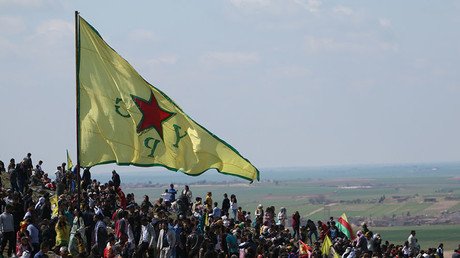What the US and Turkey really want in Northern Syria
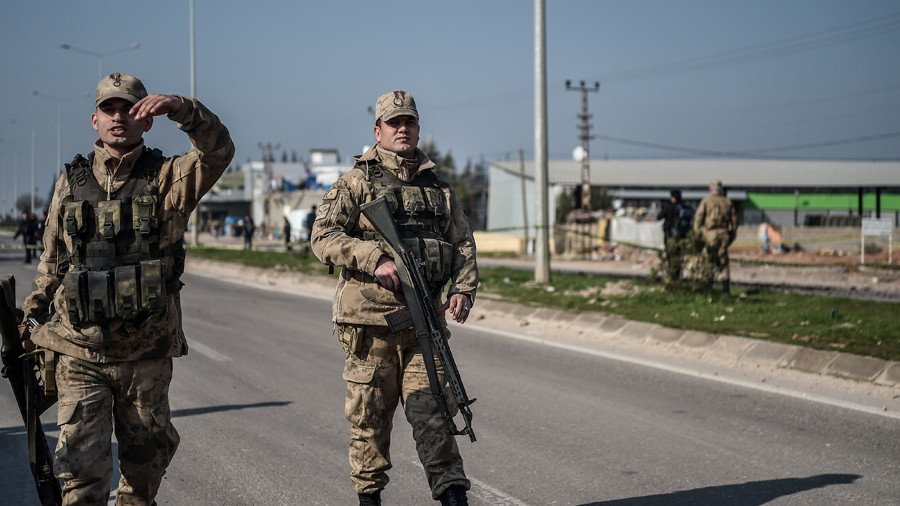
The Kurdish region of Afrin in northern Syria has become a new geopolitical pivot point in the conflict. With so many actors’ interests overlapping, whose positions will be weakened and whose solidified if hostilities escalate?
With so many different agendas now converging along the borderlands, many fear that Turkey’s latest military masterplan and march towards Afrin threatens to open up a dangerous new front in the Syrian War, but it also has the potential to incite a brand new wave of extremist factions pouring into the area – posing news risks for Syria.
On January 20, Ankara launched Operation Olive Branch (ostensibly Operation Euphrates Shield part two), which includes air and ground operations into northern Syria designed to “cleanse” Kurdish People's Protection Units (YPG) fighters from the area, whom it considers a grave security threat. As a result, Kurdish militias and Afrin residents are under threat of bombardments from an encroaching Turkish-led coalition that includes many of the same extremist factions previously driven from places East Aleppo and Homs, including the Free Syrian Army (FSA) and others.
All the signals coming from Ankara are that it is escalating in Afrin, including a recent announcement of a deployment of Turkish Special Forces into the region.
As Turkey’s Foreign Minister Mevlut Cavusoglu told Al Jazeera earlier this month, “We warned them. We warned the countries [like the US] who have been engaged with them. Nevertheless, they increased the harassment fires. That's why we launched this operation..."
Isolating Damascus from the Kurds (and vice versa) seems to be a key component to the overall Turkish strategy, and President Recep Tayyip Erdogan made no effort to veil his intentions on this matter, as reported by Hurriyet newspaper last week, “Thanks to the siege, the YPG will have no room for bargaining with the Syrian regime.”
Last week the YPG announced, "After a month of our forces' epic resistance to the Turkish invasion and the terrorist organization allied with it… we welcome the Syrian government and its army to perform its duty by participating in defending Afrin and protecting the Syrian borders." The result was a deployment of Syrian National Defense Force Units who arrived in Afrin on the February 21 to help defend residents from the current siege being waged by Turkey. In addition, Afrin militias have also called upon US-backed YPG-affiliate Syrian Democratic Forces (SDF) to provide reinforcements, although it’s not yet clear what level of commitment can be made. The SDF also fall under the purview of its US benefactors.
Effectively abandoned by the US, local Kurdish YPG reached out to Damascus for assistance, but conditions set forth by Damascus included returning Afrin to full Syrian administrative control, but with its resources stretched to the limit on multiple fronts it’s unlikely that the Syrian Arab Army will be deployed there anytime soon.
What Turkey wants
Erdogan claims to have an iron-clad mandate due to a deal that was brokered behind closed doors between Ankara and Moscow ‘greenlighting’ this latest incursion into Syria. He stated on TV in January, "We are determined. Afrin will be sorted out. We will take no step back. We spoke about this with our Russian friends. We have an agreement," although Moscow never confirmed that such a deal took place.
Ankara’s entire premise for this latest operation rests on the claim that Syria’s Kurdish Democratic Union (PYD) and YPG militias are terrorist organizations and that the Turkish-based Kurdistan Workers’ Party (PKK), claiming that the PKK are also active in Afrin, therefore, they are a threat to Turkey’s security. Certainly, the CIA hasn’t helped the Kurdish cause by listing the Syrian PYD as a branch of the PKK in Turkey and under the illustrious heading of ‘foreign-based terrorist groups’ in their 2018 World Factbook.
Salih Muslim, former chairman of the Democratic Federation of Northern Syria, now a diplomatic committee member of the PYD-led Movement for a Democratic Society (Tev-Dem) in Northern Syria said:
“We stated from the beginning we have no relations with anybody, we are just thinking of Syria, and there is no PKK in Syria in Afrin. The people are defending in Afrin - they are just the sons and daughters of Afrin. They organized themselves to protect their villages and since five years they are defending Afrin against all these brutals [like ISIS], and recently Turkey attacked them… Turkey was trying to make some tricks for us, I mean to pull us to somewhere, but they were supporting Daesh and in Kobani … they were openly supporting Daesh against the Kurdish people.”
Shortly after giving that interview to Al Jazeera, Muslim was detained by an Interpol unit in Prague, who then notified Turkish authorities who had raised an extradition order. Czech authorities have since released Muslim.
Other prominent Kurds have also spoken out, echoing Muslim’s claims, suggesting that Turkey’s claim of 10,000 PKK terrorists occupying Afrin’ is a gross over exaggeration, which if true, means that Turkey has launched a war of aggression on false pretenses.
There is also the question of whether Erdogan has wide public support for the war he is waging in Syria. The longer the story drags on, and the more public resources it consumes, the more problems Ankara will face, as it’s already attempting a delicate balancing act after suspending its constitution in 2017 and declaring a semi-permanent state of emergency. With this and other concerns in mind, the idea of committing large numbers of troops to Afrin is not ideal, and so Turkey has enlisted its resident brigades in the Free Syrian Army for forward operations. While some in the West still regard them as legitimate ‘moderate rebels,’ for Syrians living in places like Aleppo, Ma’alula and Homs - the FSA are regarded as terrorists. During their joint occupation with al-Nusra, ISIS and others in East Aleppo (2012-2016), FSA brigades were implicated in some of the worst acts violence against residents, as well as the systematic destruction of the city’s once-thriving industrial sector.
Bearing this in mind, from a Syrian perspective Operation Olive Branch could be viewed as a re-invasion of northern areas by the very same terrorist groups that had been ejected previously following the liberation of East Aleppo and other areas since. With the help of the Reconciliation Center, and through the Astana Process, scores of militants have been removed from combat zones over the last 18 months and funneled north into Syria’s Idlib province, while others have taken up residence just over the border in Turkey’s Hatay province and in neighbouring Gaziantep province. This could provide an opportunity for Syria and Russia to make key advances in Idlib.
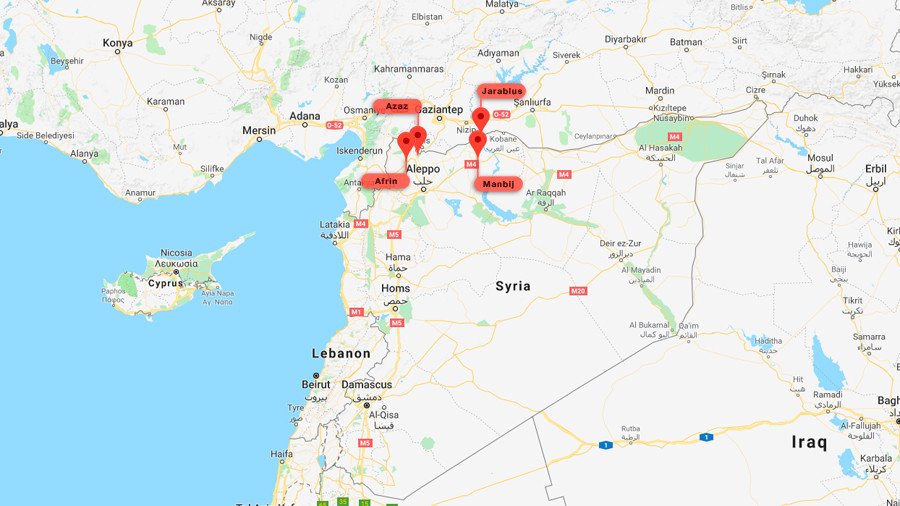
Clearly, Turkey has an overall strategic overall objective, which could be to connect Jarablus to Manbij, to Azaz, to Afrin, and then finally to Idlib. This would give Ankara enough strategic leverage to dictate any number of terms going forward. Critics have accused Turkey of micro-colonial designs, pointing out how in the Syrian border city of Jarablus, Turkey has already trained its own “Free Police,” complete with Turkish flags emblazoned on their shoulders. In Jarablus the Turkish lira is an accepted currency, Turkish telecoms are providing cellular service, and Turkey has already run underground power lines to become the city’s electricity provider.
According to analyst Dr. Can Erimtan, Erdogan’s forays into northern Syria are not strictly of a micro-colonial nature, but could be geared more towards the president’s own transformational political Islam agenda at home, explaining, “[r]ather than expanding the New Turkey into the territories of Syria, I would argue that Tayyip Erdoğan is here now invoking a Gaza [holy war or raid] spirit that would transform the erstwhile nominally secular Kemalist Republic of Turkey into a fully-fledged Islamic state on the back of the military operations carried out next door in the lands once legitimately held by Assad.”
This theme was echoed on January 26, when Erdogan spoke to the Expanded Meeting of the AKP Provincial Heads in Ankara and rounded off his rousing address with the following, “this PKK, this PYD, this YPG, this Daesh have no connection with Islam … These [terrorists] don’t know Allah, [they] don’t know Islam, [and they] don’t know Muslims.”
Anyone who has been paying attention since the 2016 coup that wasn’t, will tell you how, as a matter of practice, when speaking to his domestic base, Erdogan infuses all of his public statements with a strong religious fervor. Such is the new tone in this post-Kemalist Turkey.
All of this makes Russia’s role in Syria all the more complicated, as it has to balance its wider geopolitical role as a regional peace broker, with the fluctuant activity of Turkey and its multiplex interested parties and colliding agendas, amid a backdrop of unrelenting hostilities on the ground in Syria.
What the US Wants, What the US Needs
While the US and Turkey share certain prime directives in Syria, like removing Bashar Assad from power, other interests appear to be in conflict. However, both are enjoying a freehand within their respective comfort zones, especially the US.
After announcing the US was seeking a “30,000-strong border force in northern Syria,” Secretary of State Rex Tillerson was forced to walk back his statements after realising the storm he had caused in Ankara. To further complicate matters, Turkey has also threatened that if US forces in the northeastern region are operating as part of SDF/YPG patrols, then they could also be targeted by the Turkish military.
For the US, its presence in Syria may have symbolic value in terms of trying to maintain its dwindling position as the major player in regional affairs, but now that the ISIS narrative is fading from the headlines, the issue of Syria is barely relevant at home. Not so for Turkey, as its anti-YPG/PYD campaign is an integral part of its domestic agenda, as well as part of a wider Turkish project including its new presence in Africa where it seeks to establish itself as a hemispheric geopolitical actor.
What’s most interesting about Turkey and the US is that where there appears to be a lack of coordination and a clear set of diverging interests causing the two NATO member states to cross their geostrategic wires – they are both enjoying the enduring benefits of operating illegally in a foreign country - under the subtle protection of NATO’s Article 5 framework. The fact remains that neither NATO member has experienced any physical threat or had notice served by Syria or Russia, although under international law they would be within their right to do so.
With ISIS effectively contained, and it is a negligible threat in both Syria and Iraq, the US has latched on to the Kurdish issue as Washington’s public-facing raison d’état. This could trigger concerns not just in Syria, but also in Turkey, Iraq, and Iran. The threat of joining-up an autonomous Kurdish ‘Rojava’ in Syria with the Iraqi Kurdistan to create a contiguous Kurdish nation-state will always fuel as much interest as it will anxiety. In reality, it’s far from practical. Contrary to the popular beliefs of nation-builders in Washington, the Kurds are far from a monolithic ethno-political entity, even within Syria. Still, the US is doing its best to supply many of the trappings of Kurdish independence in northeastern Syria, not just by providing weapons, training and logistical support for its SDF proxies, but also establishing new military garrisons. US State Department officials have already been spotted in Raqqa promising new reconstruction and infrastructure projects in the pipeline.
Much of the US plan to prop-up Kurdish independence in Syria has been predicated on demographic shifts around places like Raqqa, Manbij and Qamishli. In this way, ISIS performed the necessary groundwork in driving out Arabs and minorities, with the SDF seamlessly moving in afterwards. As it turns out, this unlikely smooth transition between ISIS and the SDF occupations is now on record as having been brokered by the US (although you won’t hear that on the BBC or CNN).
As stability returns to the region, Arabs and other minorities, including Christians, Assyrians and Yazidis who had fled the violence, will gradually return, which poses another set of problem for the utopian dream that is Rojava. Following a recent fact-finding mission in the Kurdish-held region of Syria, Professor Fabrice Balanche made the following observations:
“Currently, local Arabs in northern and eastern Syria are particularly frustrated by the Kurdish Democratic Union Party (PYD), which has subverted tribal leadership while taking over many areas and largely ignored the recommendations of tribal councils in Manbij and other locales. Even in Raqqa, a city with no sizable Kurdish population, street signs that used to be in Arabic now include Kurdish, and councils are headed by Kurdish officials. PYD leaders seem to believe that it is their job to show Arabs the proper way to govern, treating their occupation as a ‘democratizing’ project. Yet the situation is stable for now because Kurdish forces provide security.”
So, despite the outward appearance of a secessionist agenda, it does not appear that Syrian Kurds have the same statehood ambitions as their Iraqi ethno-compatriots. Kurdish spokesperson Salih Muslim reiterated this position on a number of occasions, including in late 2016 when he stated that unlike Barzani’s Kurdistan Democratic Party (KDP), the PYD in Syria does not desire an independent Kurdish breakaway state from Syria, and would rather work within a pluralistic Syrian federal system. This is fairly consistent with the PYD’s founding principles, which steer away from the idea of ethno-nationalism.
Besides this, the Kurds only really have two major areas where they hold an outright demographic majority - in Afrin and Kobani. And with Afrin already veering towards Damascus and away from the US, declaring an autonomous region without a clear-cut demographic majority is nearly impossible, unless ISIS could be revived to re-plunder the region or intense fighting broke-out between Turkey and the YPG and the Syrian Army, in which case the US would most likely have to recuse itself to avoid being embroiled in something much worse than we are seeing now.
One common Western talking point among skeptics is that once the US gets what it wants, the Kurds will be the ultimate losers and will ‘eventually be discarded, as they were in Iraq’, or in this case, ‘back into the clutches of Assad.’ Again, this would be another oversimplification of the Kurdish situation in Syria, and it belies the reality of their own political ideologies and struggle, which is still ongoing and is unlikely to change radically should the US pull up stakes in Syria.
It’s important to note that Turkey has previously engaged the PYD in protracted diplomatic talks, but it seems to have fallen permanently out of favour because the PYD did not firmly oppose the government in Damascus - as Turkey had demanded in 2013. To be sure, from a strategic perspective, Ankara views the PYD as a potential obstacle to its own desire to see a weak, dismembered Syria, and without Bashar al-Assad in the Presidential Palace. As such, both Turkey and US, and Israel too, share the common objective of undermining Syria’s political and structure integrity, and therefore, are unlikely to impede each other’s actions to those ends.
One problem Washington and its new administration have is that, at present, there is no discernable foreign policy, and any demonstrative foreign policy noises, like opposing Russia or ‘rebuilding America’s defenses,’ appear to be tied to the domestic political bloodbath at home. Despite all this, the long-term geopolitical continuity of the US still endures, which would dictate that the US occupation of land and air in Syria probably has very little to do with Kurdish autonomy, and even less to do with defeating ISIS. The fact that the US is there means that they could remain there indefinitely because Russia has left them with little other option.
What happened in October 2015 should be regarded as one of the biggest geopolitical realignments in the Middle East post-Suez. Russia effectively changed the course of the regional affairs when it formally announced its entry into the Syrian conflict and, with that, changed the course of the war back in favour of Damascus. For the first time in decades, the US found itself on its back heals, and no longer at the center of regional negotiations. Later that same month, another potential turning point arose when Turkey shot down a Russian air force jet along the Syrian-Turkish border. Had Russia escalated or retaliated, and relations became so inflamed that words were exchanged which couldn’t be walked back, it is unlikely that Russia and Turkey would be on their current diplomatic footing, much less sharing the top table together at the Astana Peace Process, which many rightly regard as a major shift in the region’s geopolitical center of gravity from West to East, or more specifically, from Europe (Geneva) to Eurasia (Astana). From a realist perspective, the most significant body in this new geopolitical constellation is Russia, which brings us back to why the US is talking up what appears to be taking up a permanent residency in Syria. If the US were to, as President Donald Trump recently intimated, “get ISIS and go home,” then that means that all major decisions in the Middle East would have to go through Moscow and not Washington DC. This would be a paradigm shift not just for the US, but for its allies too, which itself could trigger yet another major geopolitical realignment. In the case of northeastern Syria, that would then leave Russia and Turkey to mediate all major decisions in Syria and along its borders. Such a scenario would likely mean a swift elimination of any remaining ISIS enclaves, leaving Damascus free to maintain its own borders and territorial integrity, which would include regaining control of its most productive oil fields in the Deir Ezzor area southeast of Raqqa – oil fields which are currently occupied by US-backed Kurdish SDF.
A continued US presence ensures that none of that can happen. Instead, ISIS will continue its role as agent provocateur and territorial rooster, while the Kurdish occupations of Syrian oil means that Syria’s post-war economic recovery will be a long and painful one – an outcome which suits Turkey, Saudi Arabia, Israel, the US and its allies.
While Syria may not be a major oil producer compared to its Arab neighbours, it is still a vital lifeline in the current embargo environment. Allowing Damascus control of its own natural resource would help tremendously in terms of sanctions-busting and help towards economic rebalancing and reconstruction.
The current US-EU double raft of sanctions on Syria is hardly mentioned in western circles and is often regarded as a ‘soft’ alternative to full-on military intervention. As a result of this, and the US-Backed SDF seizure of Syria’s oil fields from ISIS, Damascus faces the daunting prospect of having to buy its own oil back from the Kurds.
US Secretary of State Rex Tillerson appeared to be boasting about this during a recent speech on February 13 at a conference Kuwait:
“The United States and coalition forces that are working with the US to defeat ISIS today control 30 percent of Syrian territory and control a large amount of the population and control a large amount of Syria's oil fields this upwards observation that the US has very little leverage or role to play is simply false.”
What the US desperately needs is to be able to create facts on the ground, because only then can you effectively steer events your own way. The real danger is that the longer the US stays in Syria and continues to help facilitate this current era of chaos, the higher the probability that US forces will eventually be engaged in a combat situation against forces other than ISIS, which might result in the US sustaining casualties. When that happens, it could trigger yet another wave of Western military escalation, plunging Syria and the region further into crisis.
There is also the wider US-Saudi-Israeli strategy of Iranian containment, which may also be driving the current policy, or as analyst Sharmine Narwani explained, a “US policy would seek to sever the unimpeded geographic line between Iran and Israel by creating a buffer entity that runs through Iraq and Syria.”
Given enough time, the Syrian Arab Army (SAA) and its partners will clear many of the remaining terrorist pockets like East Ghouta, and will eventually move on to Idlib. When this happens, it is conceivable that the SAA could be deployed to Afrin, which could be a ‘win-win’ for Syria, and even for Turkey, who would have little choice other than to accept Syria securing its own borders.
For all parties, the current situation in northern Syria is simply unsustainable, and the continued illegal US presence in Syria will do nothing other deny Damascus and Ankara any chance to reach an accord and move ahead in stabilizing the borderlands.
When the music finally stops, and this game of musical chairs is over, someone will have to leave the game.
The statements, views and opinions expressed in this column are solely those of the author and do not necessarily represent those of RT.

